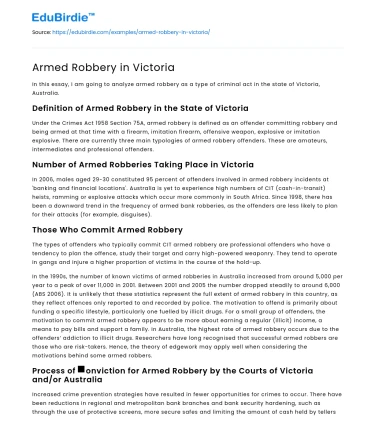In this essay, I am going to analyze armed robbery as a type of criminal act in the state of Victoria, Australia.
Definition of Armed Robbery in the State of Victoria
Under the Crimes Act 1958 Section 75A, armed robbery is defined as an offender committing robbery and being armed at that time with a firearm, imitation firearm, offensive weapon, explosive or imitation explosive. There are currently three main typologies of armed robbery offenders. These are amateurs, intermediates and professional offenders.
Save your time!
We can take care of your essay
- Proper editing and formatting
- Free revision, title page, and bibliography
- Flexible prices and money-back guarantee
Number of Armed Robberies Taking Place in Victoria
In 2006, males aged 29-30 constituted 95 percent of offenders involved in armed robbery incidents at 'banking and financial locations'. Australia is yet to experience high numbers of CIT (cash-in-transit) heists, ramming or explosive attacks which occur more commonly in South Africa. Since 1998, there has been a downward trend in the frequency of armed bank robberies, as the offenders are less likely to plan for their attacks (for example, disguises).
Those Who Commit Armed Robbery
The types of offenders who typically commit CIT armed robbery are professional offenders who have a tendency to plan the offence, study their target and carry high-powered weaponry. They tend to operate in gangs and injure a higher proportion of victims in the course of the hold-up.
In the 1990s, the number of known victims of armed robberies in Australia increased from around 5,000 per year to a peak of over 11,000 in 2001. Between 2001 and 2005 the number dropped steadily to around 6,000 (ABS 2006). It is unlikely that these statistics represent the full extent of armed robbery in this country, as they reflect offences only reported to and recorded by police. The motivation to offend is primarily about funding a specific lifestyle, particularly one fuelled by illicit drugs. For a small group of offenders, the motivation to commit armed robbery appears to be more about earning a regular (illicit) income, a means to pay bills and support a family. In Australia, the highest rate of armed robbery occurs due to the offenders’ addiction to illicit drugs. Researchers have long recognised that successful armed robbers are those who are risk-takers. Hence, the theory of edgework may apply well when considering the motivations behind some armed robbers.
Process of Сonviction for Armed Robbery by the Courts of Victoria and/or Australia
Increased crime prevention strategies have resulted in fewer opportunities for crimes to occur. There have been reductions in regional and metropolitan bank branches and bank security hardening, such as through the use of protective screens, more secure safes and limiting the amount of cash held by tellers. Aggravated robbery can incur a maximum penalty of 20-25 years imprisonment.






 Stuck on your essay?
Stuck on your essay?

